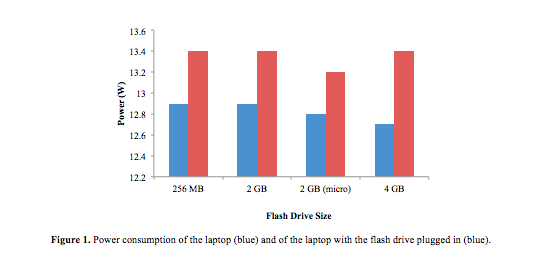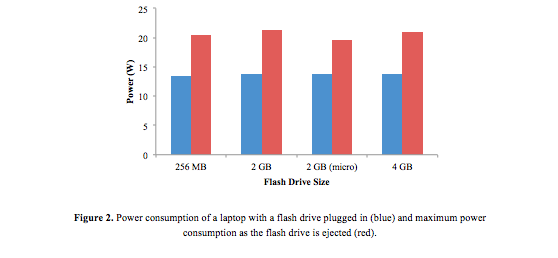Historical Introduction to Flash Drive Price Versus Memory Capacity
This is certainly the case with memory capacity. $200 could buy you 8 MB of memory in 2000 (year that USB 2.0 flash drives were first introduced to the public), as opposed to 2GB of memory in 2005, and 128 GB of memory in 2010. Today, the average-sized 4 GB flash drive sells for around $10. Perhaps these increases in memory capacity reflect changes in everyday flash drive use – particularly in the domains of computer maintenance, law enforcement, business, and entertainment, where 4 GB of memory represents optimal balance between cost and desired memory capacity.
However, this does not imply that the power consumption efficiency of flash drives has seen similar gains. Our investigation attempted to establish whether or not larger drives are associated with smaller power consumptions.
Source: www.ehow.com

Results and Conclusions
The graphs in figures 1-3 show the power consumption of the laptop at rest and of the laptop with the flash drive when it is plugged in, as it opens files, and as it is ejected. Tables 1-3 summarize the data (in a previous blog post).
The data does not point to there being a significant difference among the flash drives and the amount of power they consume. Though we believed that flash drives with greater capacity would be more efficient and would consume less power than would smaller ones, especially older ones like the 256 MB, we did not observe a trend in our experiment. The differences that we did observe may be due to normal fluctuations in power consumption of each flash drive and may not be statistically significant. Some background tests in which a file was opened from the same flash drive more than once show that the power consumption reading on the watts up? PRO fluctuates and is not the same each time. It is clear from the data that a computer into which a flash drive has been plugged in consumes more power overall than a computer that has nothing running on it (figure 1). Ejection of a flash drive consumes about the same amount of power regardless of the size of the flash drive, though the 2 GB drive consumed the most power (+7.6 W), and the 2 GB micro flash drive consumed the least (+5.8 W). Whether this is a real trend, however, is uncertain because it was not observed when opening documents from flash drives.
In order to check whether the power consumption recorded when opening files is due to the flash drive or the computer, the same file was also opened from the computer. The data are inconsistent, however, and it is difficult to tell which device is consuming power, or whether there is a trend among different flash drive sizes. Power consumption was greater when opening files from the computer for only some of the files; for others, it was greater when opening them from a flash drive. This suggests that there is no difference among flash drives, and also that we cannot tell which device is consuming power, a confounding variable that must be eliminated in future experiments.
Overall, power consumption increases when a flash drive is plugged into a laptop, but it is unclear whether larger-capacity flash drives consume more or less power, whether they are merely plugged in or opening files. Future experiments should focus on a more rigorous statistical treatment of data, more of which should be collected using many different types of flash drives. Each type of flash drive should be tested multiple times (preferably three or more) and its power consumption should be recorded. Standard deviations should be determined, which can help eliminate or, at the least, pinpoint some of the uncertainties regarding fluctuations in power readings. It would also be interesting to test particular sizes of flash drives and determine if there is a difference in power consumption among different brands.


